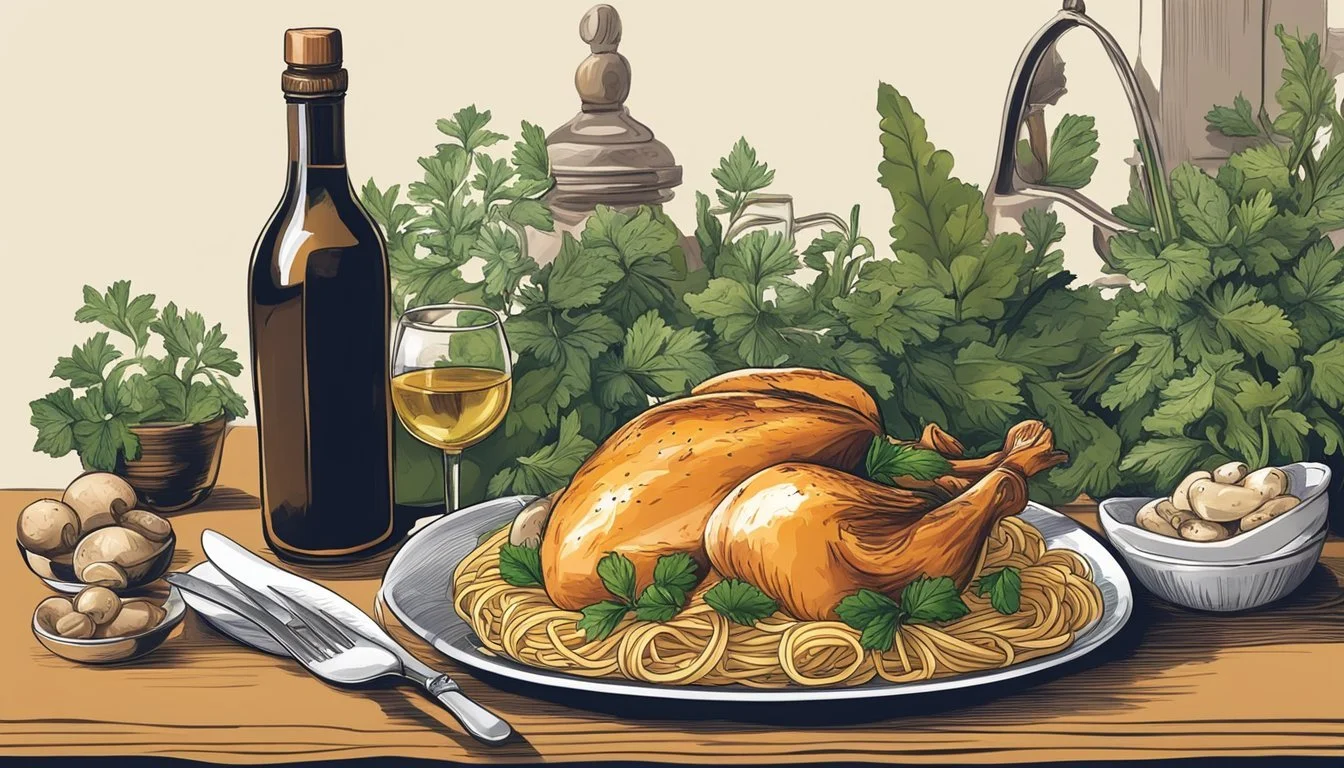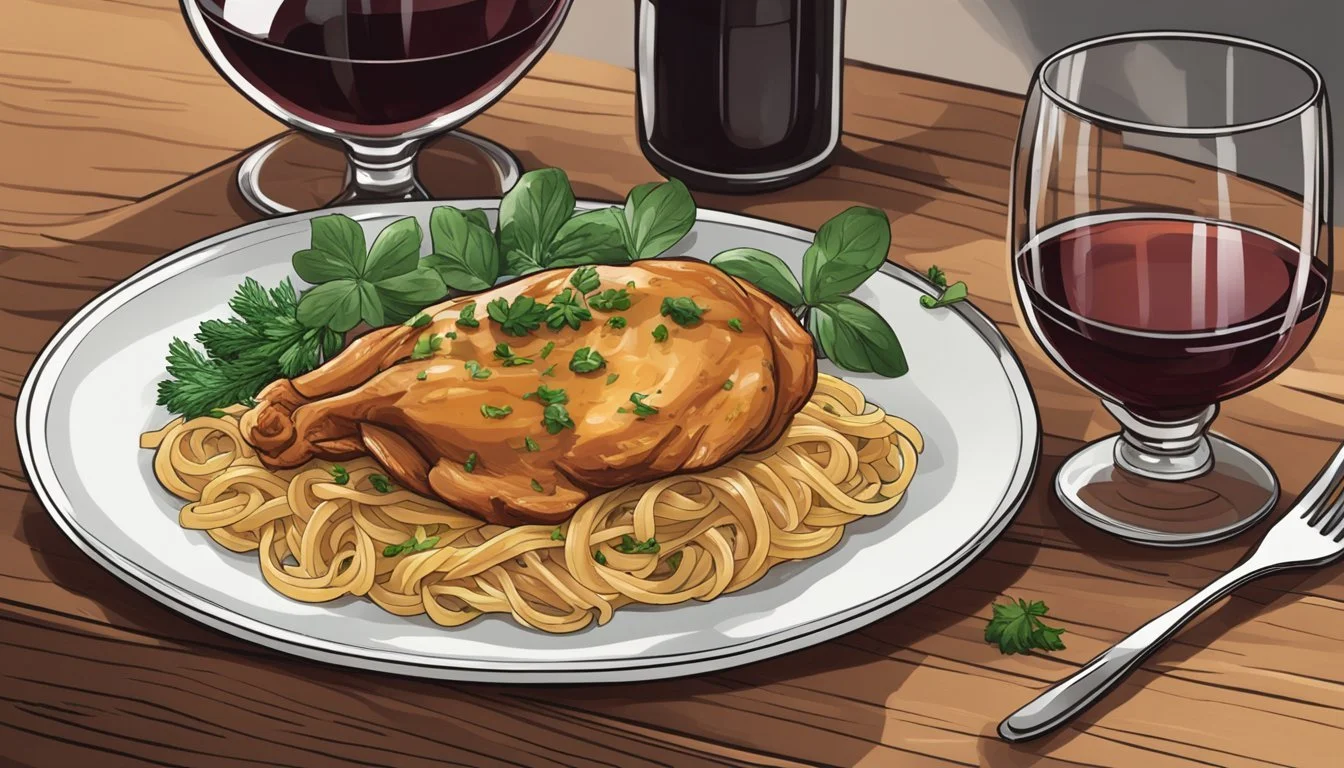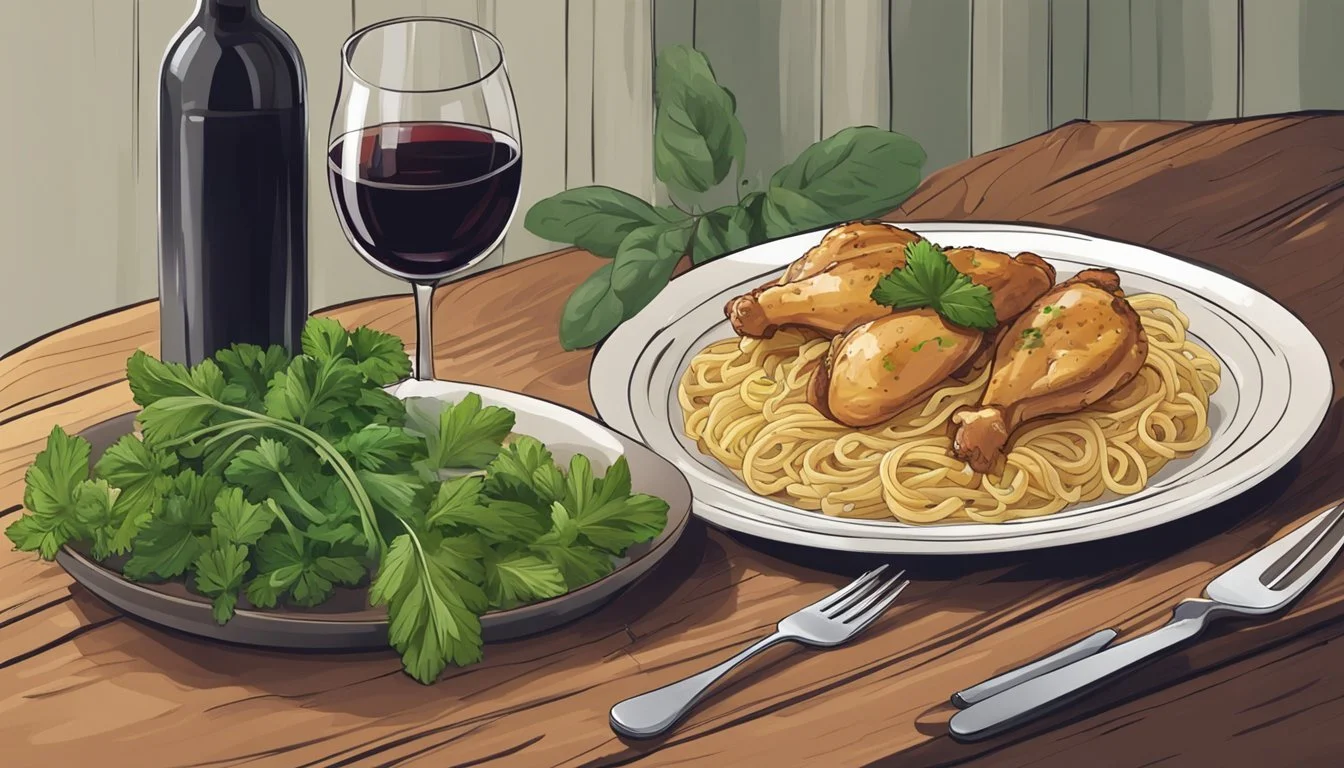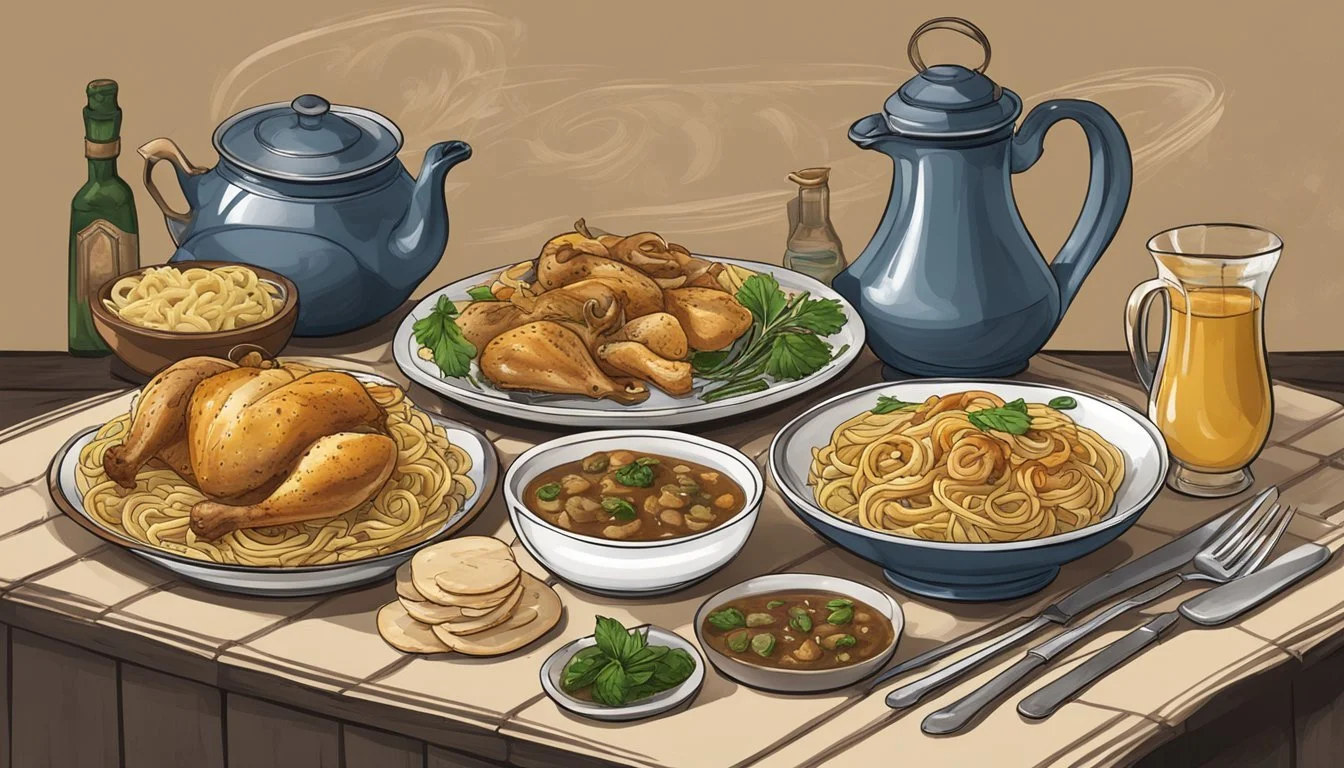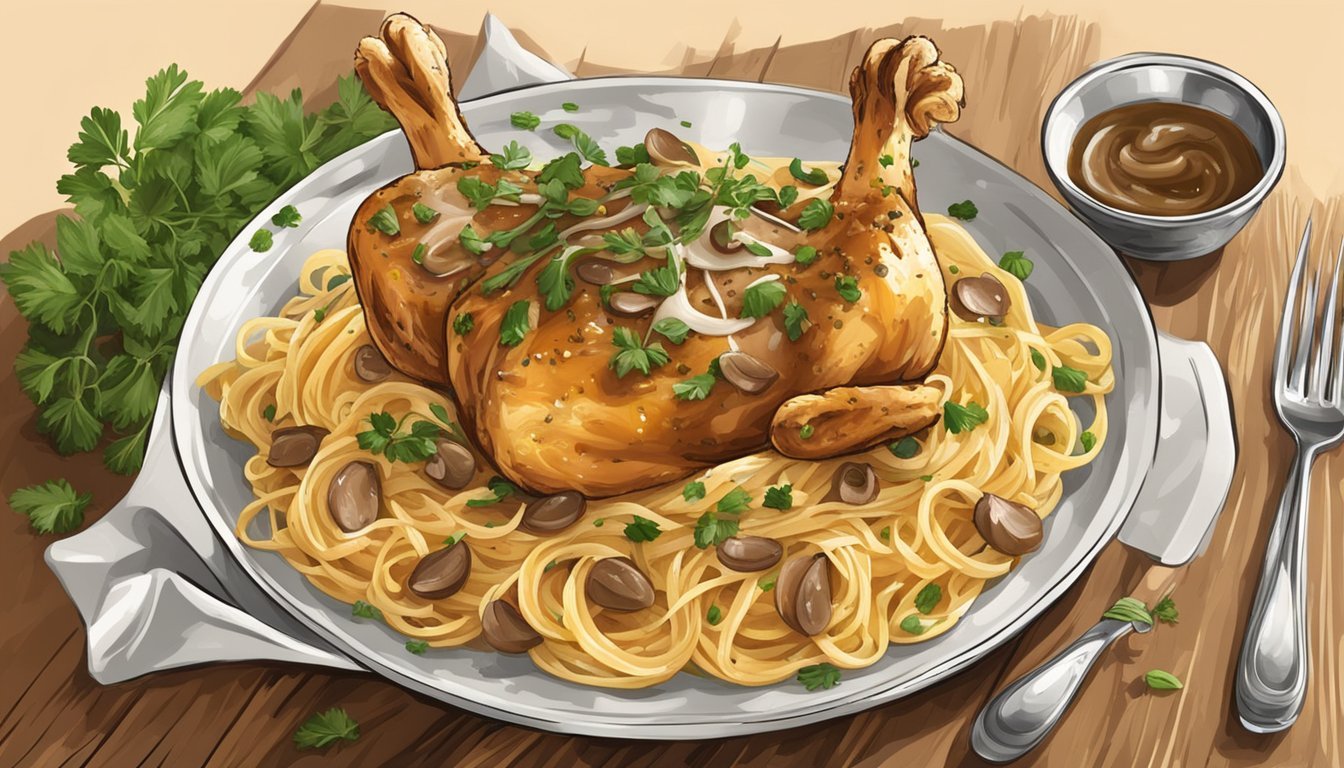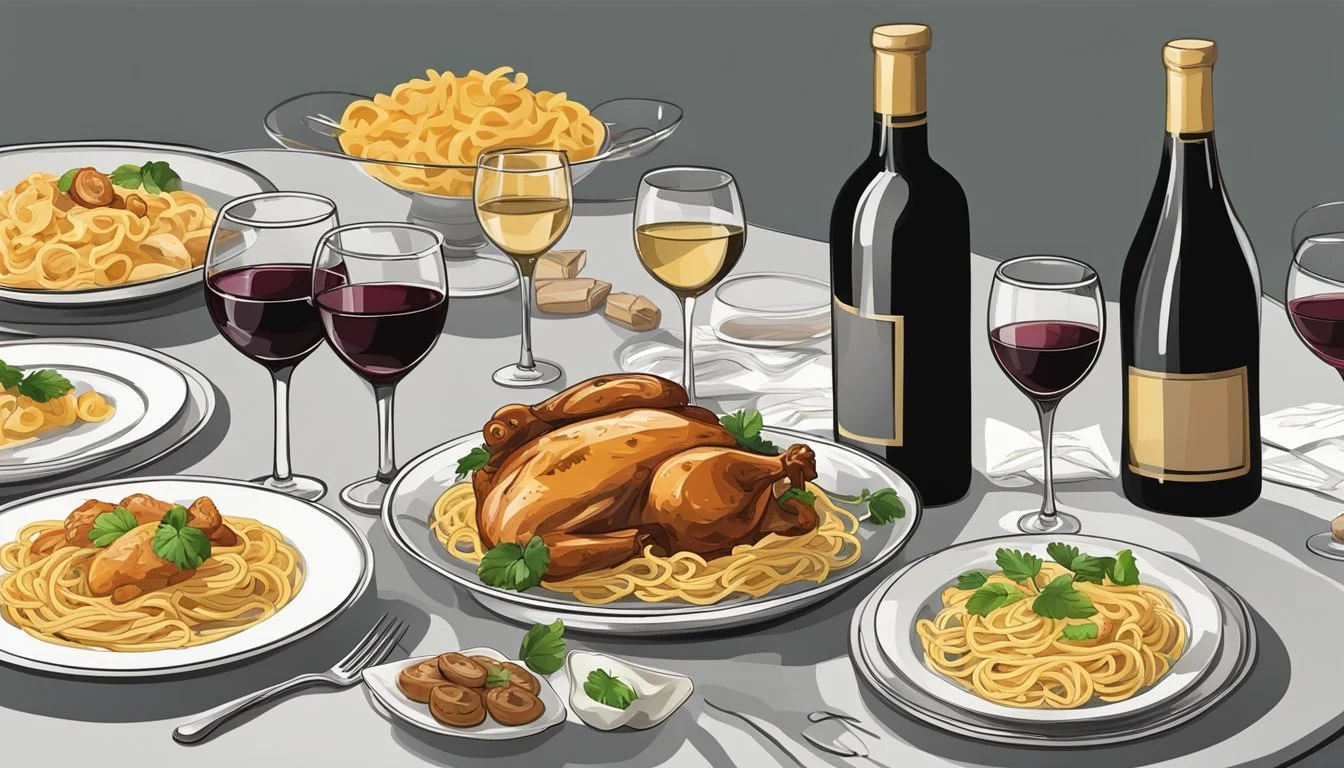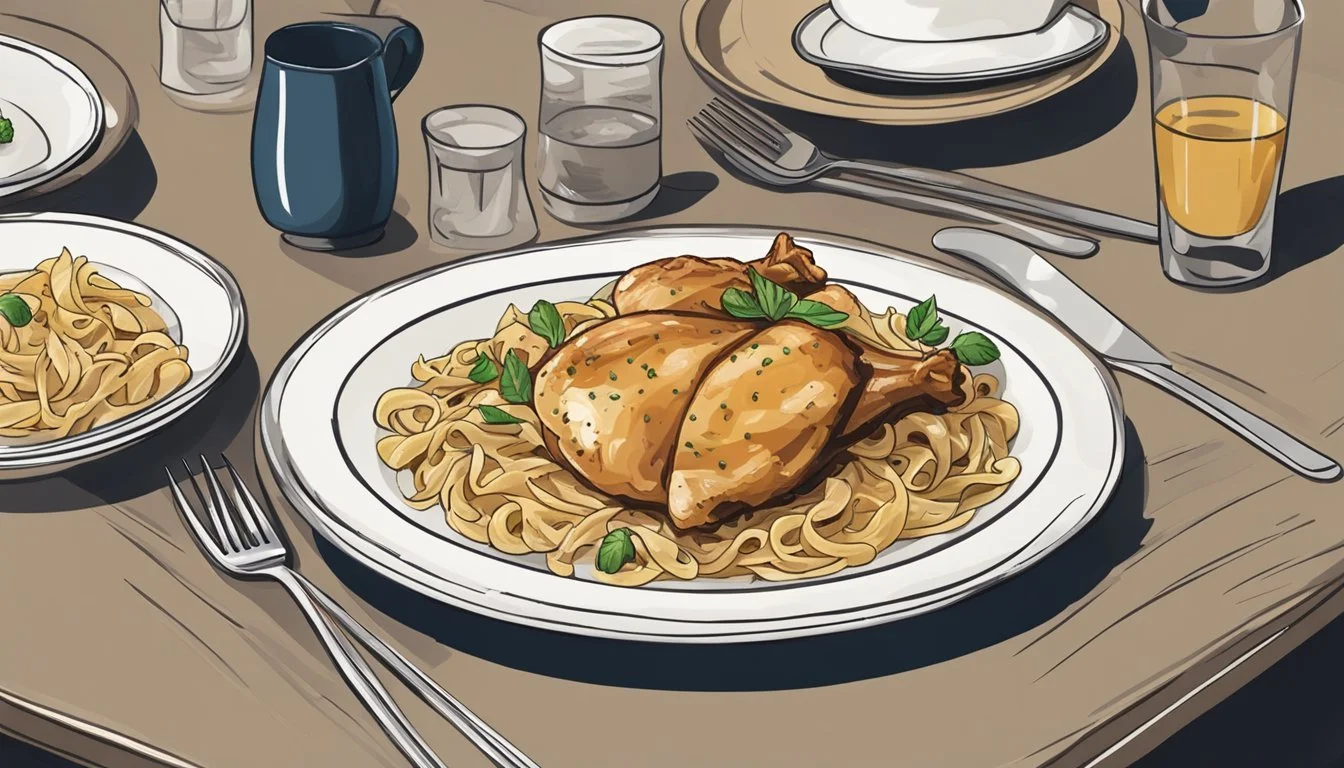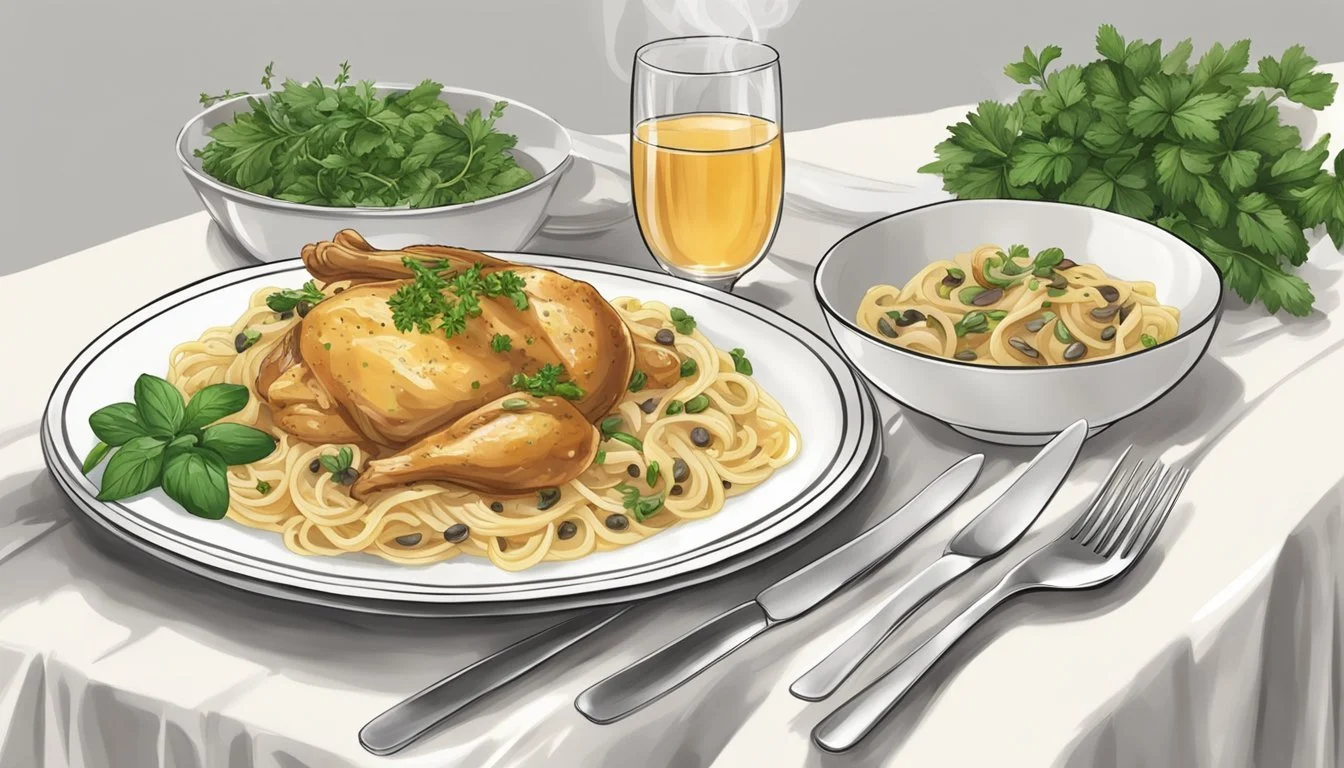How Long Does Chicken Marsala with Pasta Last?
A Shelf Life Guide
Are you a fan of Chicken Marsala paired with pasta and wondering about its shelf life? You’ve come to the right place. Properly stored, Chicken Marsala with pasta can last in the fridge for up to 3 days, making it a convenient option for quick and tasty weeknight dinners.
This classic Italian dish combines tender chicken, robust Marsala wine, and satisfying pasta. Its flavors improve over time, making leftovers a delight. To maintain its quality, store the dish in airtight containers within two hours of cooking.
Revamp your weekly menu with this delicious recipe. Serve it at dinner, store it correctly, and enjoy it again without sacrificing taste.
Ingredients Overview
Chicken Marsala with pasta requires careful selection of ingredients like chicken, Marsala wine, mushrooms, herbs, and pasta types. Ensuring quality in each aspect is crucial to achieving a restaurant-quality dish.
Poultry Selection
Choosing the right poultry is essential for Chicken Marsala. Chicken breasts are the preferred cut due to their tenderness and ability to quickly absorb flavors. Look for boneless, skinless breasts which will cook evenly. It's best to buy fresh, organic chicken to ensure minimal exposure to antibiotics and hormones. Properly trim any excess fat from the chicken breasts before cooking.
Marsala Wine Varieties
Marsala wine is the cornerstone of this dish, imparting its distinctive taste. There are two primary types: dry Marsala and sweet Marsala.
Dry Marsala: Better for savory dishes, providing a subtle, nutty flavor.
Sweet Marsala: Adds a richer, caramelized sweetness, more suitable for desserts but can be used for a twist in Chicken Marsala.
Opt for a high-quality Marsala wine available in most wine stores.
Mushrooms and Vegetables
Mushrooms play a supportive yet crucial role in Chicken Marsala. Button mushrooms are commonly used due to their mild flavor and ability to soak up the sauce. Cremini mushrooms offer a deeper, earthier flavor.
Salt
Finely chopped garlic
Shallots or onions for added depth
Ensure these vegetables are fresh to maintain the integrity of the dish.
Herbs and Spices
Flavor enhancement comes from an array of herbs and spices. Thyme and nutmeg are often key players.
Use fresh or dried thyme.
Grate nutmeg freshly if possible.
Salt, black pepper, and garlic powder are basic seasonings that should not be overlooked to achieve the complex yet harmonious flavor profile.
Dairy and Fats
Balancing fats and dairy is vital. Olive oil is the cooking medium in many recipes, lending a fruity undertone without overpowering the dish. Butter adds richness and a creamy texture.
Some variations include adding heavy cream for a richer, creamier sauce, transforming the standard Chicken Marsala into a decadent feast. Only add these if aiming for a luxurious finish.
Pasta Types
Pasta complements the Chicken Marsala, acting as a vessel for the flavorful sauce. Fettuccine and linguine are popular choices that hold the sauce well.
Fettuccine: Wide and flat, perfect for heavy sauces.
Linguine: Slightly thinner than fettuccine but still ideal for the creamy sauces of Chicken Marsala.
Ensure to cook the pasta al dente to maintain the ideal texture when merged with the sauce.
Cooking Chicken Marsala: Step-by-Step
Cooking Chicken Marsala requires preparing the chicken breast, creating a rich Marsala sauce, and cooking pasta to complement the dish. Each step demands attention to detail for an authentic and delicious result.
Preparing Chicken Breast
Start by halving and flattening the chicken breasts to ensure even cooking. Place each piece between plastic wrap and use a meat mallet. Season with salt and pepper.
Dredge the chicken in flour, shaking off excess. Heat olive oil and unsalted butter in a large skillet over medium-high heat.
Cook the chicken until golden brown, about 4 minutes per side. Transfer to a plate and cover with foil to keep warm.
Creating Marsala Sauce
Slice cremini mushrooms thinly and sauté in the same skillet with additional butter. Once the mushrooms brown, deglaze with dry Marsala wine, ensuring to scrape the bottom of the skillet.
Add chicken broth and bring it to a simmer. Season the sauce with salt, pepper, and finely chopped Italian parsley.
Optional: To make a creamy version, stir in heavy cream after simmering. Return chicken to the pan, coating with sauce and cooking until heated through.
Cooking Pasta to Perfection
Choose a pasta like fettuccine or spaghetti. Cook according to package instructions in salted boiling water for al dente texture.
Drain and toss with a bit of unsalted butter to prevent sticking. Plate the pasta alongside the chicken, generously topping with the Marsala sauce. Garnish with fresh parsley.
Storing and Preserving
Chicken Marsala with pasta can be enjoyed for several days if stored properly. Key factors include refrigeration, freezing techniques, and understanding the shelf life.
Refrigeration Guidelines
Store Chicken Marsala in the refrigerator within two hours of cooking. Use airtight containers to keep the dish fresh. Place leftovers in the refrigerator promptly to minimize bacterial growth.
Kosher salt used in the dish does not impact storage time but can enhance flavor preservation. Most leftovers remain safe to eat for up to 3-4 days. Monitor the creamy components, as dairy can spoil faster.
Freezing Techniques
Freezing is an effective method to extend the life of Chicken Marsala. For best results, place the dish in single-serving portions in airtight containers or heavy-duty freezer bags. Make sure to remove as much air as possible to prevent freezer burn.
Label the containers with the date for easy tracking. The dish maintains its quality for up to 2-3 months in the freezer. Thaw frozen Chicken Marsala in the refrigerator before reheating for optimal texture and flavor.
Shelf Life Considerations
Understanding shelf life is crucial for safety and taste. Chicken Marsala's ingredients, particularly the pasta and creamy sauce, determine its longevity. Refrigerated leftovers are best consumed within a few days to enjoy peak flavor and texture.
Freezing significantly extends shelf life, though gradual quality decline is inevitable. Always inspect the dish for unusual odors or textures before consuming. Proper storage practices ensure that Chicken Marsala can be enjoyed safely over a longer period.
Serving Recommendations
Knowing how to serve Chicken Marsala with pasta can enhance the dining experience. Key components involve picking complementary side dishes and careful plating for an appetizing presentation.
Side Dishes
To complement Chicken Marsala, consider serving it with mashed potatoes. The creamy texture balances the savory sauce.
Another option is roasted vegetables. Carrots, bell peppers, and asparagus provide both color and nutrients.
A fresh green salad is also a good choice. Try a mix of arugula, spinach, and romaine with a light vinaigrette.
Garlic bread is popular too. It’s great for soaking up the sauce.
Plating Tips
Begin by selecting a large plate. This allows room for both the pasta and the chicken.
Arrange the pasta first, creating a nest in the center. Place the chicken on top and spoon extra sauce over it.
Garnish with grated parmesan cheese and chopped fresh parsley for a touch of color and flavor.
Use a side dish bowl for mashed potatoes or a separate plate for salads to keep the flavors distinct.
Ensure to wipe the plate edges clean before serving. This attention to detail creates a professional appearance.
Health and Nutrition
Chicken Marsala with pasta, when prepared traditionally, can offer both nutritional benefits and indulgent flavors. Ingredients like chicken, olive oil, and button mushrooms contribute to its nutritional profile.
Using skinless chicken breast as the primary protein source adds a lean selection to the dish. A serving (3.5 ounces) of chicken breast provides approximately 165 calories, with 31 grams of protein and very low fat content.
Olive oil, used in the cooking process, is a source of healthy fats. One tablespoon contains around 119 calories predominantly from monounsaturated fats, which are beneficial for heart health.
Unsalted butter, another common ingredient, adds flavor and richness. One tablespoon has roughly 102 calories and is high in saturated fat. For a healthier option, consider using butter in moderation or substituting with more olive oil.
Nutrition Information (Per Serving Estimate)
Component Amount Calories 550-700 kcal* Protein 35-45 grams Carbohydrates 50-60 grams Lipids 20-30 grams Fiber 3-5 grams
*Values may vary depending on the exact ingredients and their quantities.
Button mushrooms offer additional nutritional benefits. They are low in calories, averaging about 15 per cup, and provide vitamins, minerals, and antioxidants. This makes them a nutritious addition to the meal.
Chicken Marsala pasta can be adapted to be lighter by reducing the amount of butter and increasing the proportion of mushrooms and other vegetables. Making small adjustments can keep the dish delicious while enhancing its nutritional value.
Culinary Techniques and Tools
For creating delicious Chicken Marsala with pasta, having the right tools and knowledge of advanced culinary techniques is essential. These ensure that each component of the dish is perfectly cooked and well-flavored.
Essential Kitchen Equipment
Skillet: A cast iron skillet is ideal for Chicken Marsala. It retains heat well and helps in creating a rich, caramelized crust on the chicken.
Measuring Cup: Accurate measurements are crucial. Use a liquid measuring cup for Marsala wine and a dry one for flour.
Knife: A sharp chef's knife is essential for slicing the chicken and mushrooms uniformly, ensuring even cooking.
Olive Oil: Use high-quality olive oil for cooking. It enhances flavor and helps in achieving a perfect sear.
Shallow Bowl: Useful for dredging chicken in flour before cooking. This helps in building a crisp, golden-brown crust without overloading the dish with flour.
Advanced Cooking Techniques
Browning and Deglazing: Start by browning the chicken in olive oil in a hot cast iron skillet. Once done, remove the chicken and use balsamic vinegar and Marsala wine to deglaze the skillet, scraping up the flavorful browned bits to enrich the sauce.
Whisking Sauce: After deglazing, add cream and whisk until the sauce becomes thick and smooth. Consistent whisking prevents lumps and creates a velvety texture.
Layering Flavors: Season mushrooms just before finishing to avoid drawing too much moisture out prematurely. Add layers of flavor by introducing garlic, onions, and seasoning at different stages of cooking.
Resting Pasta: Cook pasta separately and toss with a little olive oil to prevent it from sticking. This allows the pasta to remain al dente when mixed with the sauce.
These techniques and tools ensure that Chicken Marsala with pasta is prepared with precision and skill, yielding a tantalizing dish every time.
Cultural and Historical Context
Chicken Marsala, an esteemed dish in Italian cuisine, showcases the profound culinary traditions of Italy. Originating from Sicily, this savory dish is renowned for its rich and aromatic flavors, primarily derived from Marsala wine, a crucial component.
Marsala wine, produced in the Marsala region of Sicily, lends the dish its distinctive taste. This fortified wine, available in dry and sweet varieties, plays a pivotal role in Italian cooking. Using Marsala wine in savory dishes like Chicken Marsala highlights its versatility beyond just drinking purposes.
In Italian restaurants, Chicken Marsala often features on the menu. Restaurants typically pair it with pasta or risotto to balance the dish's savory profile. The combination enriches the dining experience by merging the textures and flavors seamlessly.
Cremini mushrooms, known for their earthy flavor, complement the richness of Marsala wine in Chicken Marsala. These mushrooms, widely used in Italian cooking, add depth and nuance, enhancing the overall complexity of the dish.
Cooking methods and regional variations influence the final presentation of Chicken Marsala. While the core elements remain consistent, chefs may incorporate unique touches, reflecting local tastes and culinary creativity. This adaptability has helped Chicken Marsala maintain its popularity in various settings.
This historical and cultural backdrop illuminates the significance of Chicken Marsala within Italian gastronomy, emphasizing the depth and heritage inherent in its preparation and enjoyment. The sophisticated interplay of Marsala wine, mushrooms, and carefully selected ingredients showcases the enduring charm of this classic dish.
Customization and Variations
When preparing Chicken Marsala with pasta, there are various ways to customize the dish. Whether you are seeking alternative ingredients or looking for vegetarian adaptations, these options allow for flexibility while keeping the flavors rich and satisfying.
Alternative Ingredients
Chicken Choices: Home cooks can use chicken thighs or cutlets instead of breasts. Chicken thighs offer a richer flavor, while cutlets cook quicker due to their thinness.
Wine Variations: While sweet marsala is traditional, dry marsala wine, Madeira, or even Port can add different nuances to the sauce. Just adjust the wine quantity to balance the flavors.
Mushrooms: Commonly used button mushrooms can be replaced with cremini or porcini for a deeper, more robust taste.
Creamy Additions: For those preferring a creamier sauce, a splash of heavy cream or a dollop of mascarpone can create a luxurious texture. Adjust other liquids to maintain the consistency.
Vegetarian Adaptations
Swap Chicken with Protein Alternatives: Replace chicken pieces with firm tofu, tempeh, or even mushrooms like portobello to mimic the meaty texture.
Adjusting the Sauce: Sweet marsala and dry marsala wine work well with vegetable broth instead of chicken broth. Add a pinch of nutritional yeast for a savory depth.
Pasta Choices: Whole grain or gluten-free pasta can suit dietary needs without compromising the dish’s integrity. Use fettuccine, penne, or spaghetti as preferred.
Additional Veggies: Enhance the dish with vegetables like zucchini, bell peppers, and spinach. These not only add nutrition but also create a more complex flavor profile.
Presentation and Garnishing
A visually appealing presentation elevates the dining experience. Begin by placing a generous serving of chicken marsala over the cooked pasta. Arrange the chicken pieces neatly on top.
Sprinkle chopped parsley over the dish. This adds both color and a mild, herby flavor.
Add a touch of fresh thyme. This herb complements the earthiness of the mushrooms.
For an extra layer of flavor, sprinkle freshly grated parmesan cheese over the top. This adds a slight nuttiness.
Consider adding a few leaves of fresh basil. These can be left whole or julienned for a delicate touch.
A light sprinkling of oregano can bring out the savoriness of the dish.
Serve on a white plate to allow the colors to stand out. This simple yet elegant presentation is sure to impress.
Wine Pairing and Selection
Wine pairing for Chicken Marsala enhances the dish's flavors and elevates the dining experience.
Red Wine Pairings
Pinot Noir: Its lighter body and earthy complexity make it excellent for Chicken Marsala with a rich sauce.
Merlot: Medium tannins and fruity notes offer balance and complement the dish well.
Syrah: Earthy and spicy tones can enhance the mushroom flavors in the Marsala sauce.
White Wine Pairings
Chardonnay: A good option when you prefer white wine. Its buttery and oaky notes can complement the sauce's richness.
Chenin Blanc: Offers bright acidity and slight sweetness, creating a refreshing contrast with the savory dish.
Marsala Wine
Both dry and sweet Marsala wines can be used in cooking as well as pairing.
Dry Marsala: Ideal for cooking, adds depth to the sauce, making it robust and aromatic.
Sweet Marsala: Complements the dish when served as a pairing, adding a touch of sweetness that matches the sauce's profile.
Wine Pairing Tips
Acidity: Choose wines with moderate acidity. This helps to cut through the richness of the Marsala sauce.
Tannins: Subtle tannins are essential to avoid overshadowing the dish.
Sweetness: Slight sweetness in the wine can align well with the Marsala sauce, ensuring it's not overly sweet.
Other Varieties
Gamay: Fruity and floral, best paired with lighter Marsala sauces.
By considering these elements, one can enhance the Chicken Marsala experience through well-thought-out wine pairings.
Reader Reviews and Feedback
Many readers have praised Chicken Marsala with Pasta for its rich flavor and ease of preparation. According to Dinner, then Dessert, the dish is a hit among home cooks who appreciate its restaurant-quality taste.
Star Ratings
Well Seasoned Studio: ⭐⭐⭐⭐
Posh Journal: ⭐⭐⭐⭐⭐
Homemade Italian Cooking: ⭐⭐⭐⭐
Feedback Highlights
Readers have shared various tips to enhance the recipe. Some suggest adding heavy cream for a creamier texture. Others enjoy the dish with different types of mushrooms like cremini or portobello.
Instagram Buzz
Home chefs frequently share their creations on Instagram, often garnished with fresh herbs to make the dish visually appealing. Multiple posts highlight the dish as a comfort food that is both luxurious and simple to prepare.
Storage and Reheating Insights
There is common feedback on how to store and reheat leftovers. Most agree that Chicken Marsala with Pasta lasts for about 3-4 days when kept in an airtight container in the refrigerator. Reheating on the stovetop seems to maintain the best texture and flavor.
User Tips
People often mention that adding a bit of chicken broth during reheating helps to restore the sauce's consistency. Freezing the dish is also an option, although it might alter the pasta texture slightly.
Guidelines for Safe Consumption
Internal Temperature:
When cooking Chicken Marsala, it is crucial to ensure the internal temperature of the chicken reaches at least 165°F (74°C). Use a food thermometer to verify the temperature to avoid the risk of foodborne illness.
Storage of Leftovers:
Leftover Chicken Marsala with pasta should be promptly stored in an airtight container. Refrigerate within two hours of cooking. Properly stored, it can last up to 3-4 days in the refrigerator.
Reheating Instructions:
Reheat leftovers until they reach an internal temperature of 165°F (74°C) to ensure safety. Stir or rotate the dish during reheating to evenly distribute heat.
Freezing:
Chicken Marsala with pasta can be frozen for longer storage. Place in airtight containers or freezer bags. For best quality, consume within 2-3 months. Thaw in the refrigerator before reheating.
Avoid Reheating Multiple Times:
Repeated reheating can significantly reduce the quality and safety of the dish. Only reheat the portion you intend to consume immediately.
Check for Spoilage:
Before consuming leftovers, check for signs of spoilage. Discard any food that has an unusual odor, color, or texture.
Cooling Before Storing:
Allow the Chicken Marsala to cool slightly before placing it in the refrigerator. Rapid cooling helps prevent bacterial growth.
Professional Insight
Chicken Marsala with pasta can last for several days when stored correctly. Proper handling, from cooking techniques to storage recommendations, ensures its restaurant-quality taste and safety.
Chef’s Tips
Experienced chefs emphasize that Chicken Marsala should be stored in airtight containers to maintain its freshness. Cooling the dish promptly after cooking is crucial to prevent bacterial growth. Refrigerate within two hours and consume within three to four days.
A common practice among private chefs includes separating the pasta from the sauce. This prevents the pasta from becoming mushy and helps maintain the dish's texture. Reheat gently on the stovetop or in the microwave, adding a splash of water or broth to keep it moist.
Chefs often recommend using a meat thermometer to check that the dish reaches a safe reheating temperature of 165°F (74°C). These practices are commonplace in restaurants and professional kitchens to guarantee both safety and quality.
Cookbook Recommendations
Several cookbooks offer guidance on both preparing and storing Chicken Marsala effectively. Renowned cookbook authors often stress the importance of portioning and sensible storage.
For instance, "The Complete Italian Cookbook" suggests storing Chicken Marsala in single-meal portions. This approach not only simplifies reheating but also reduces waste, as only the needed amount is reheated each time.
"The Joy of Cooking" highlights the benefits of freezing Chicken Marsala if it will not be consumed within a few days. Properly stored, the dish can last up to two months in the freezer. When thawing, it is recommended to do so in the refrigerator overnight to retain its restaurant-quality flavor and texture.
Culinary School Basics
Culinary schools teach students about the critical principles of food safety and storage. At the heart of these lessons is the "danger zone" temperature range between 40°F (4°C) and 140°F (60°C), where bacterial growth accelerates.
Students learn that promptly refrigerating Chicken Marsala with pasta prevents it from staying in this zone for too long. Correct reheating methods, such as using a thermometer to ensure the chicken reaches 165°F (74°C), are emphasized.
Additionally, culinary schools often suggest vacuum-sealing leftovers. This method minimizes air exposure, which can degrade the dish’s quality. These foundational practices are essential for producing safe, high-quality meals in both professional and home settings.
Popular Variants and Related Dishes
Chicken Marsala often garners attention for its rich flavors and versatility. This classic dish can be easily adapted with various ingredients and has several related recipes worth exploring.
Chicken Parmesan
Chicken Parmesan features breaded chicken cutlets topped with marinara sauce and melted cheese. Unlike Chicken Marsala, which uses a wine-based sauce, Chicken Parmesan offers an Italian-American spin with its tomato and cheese components.
Chicken Piccata
Chicken Piccata is another popular variant. It involves cooking chicken in a lemon-butter sauce with capers. This dish provides a tangy contrast to the earthy, umami flavors found in Chicken Marsala, appealing to those who enjoy a citrusy zest.
Creamy Chicken Marsala
A common variation is to add heavy cream to the Marsala wine sauce, creating a creamier, richer version of the dish. The cream balances the wine's complexity, adding depth and making it more luxurious.
Related Dishes:
Chicken Marsala Pasta: Combining Chicken Marsala with pasta creates a comforting, hearty meal. Common pasta choices include fettuccine and farfalle, which effectively hold the sauce.
Mushroom Risotto: This Italian rice dish features mushrooms and often incorporates a similar savory flavor palette as found in Chicken Marsala. The creamy texture of risotto pairs well with the tender chicken.
Whether one seeks a creamy twist or a tangy alternative, these variants and related dishes offer delicious options to suit different palates.


